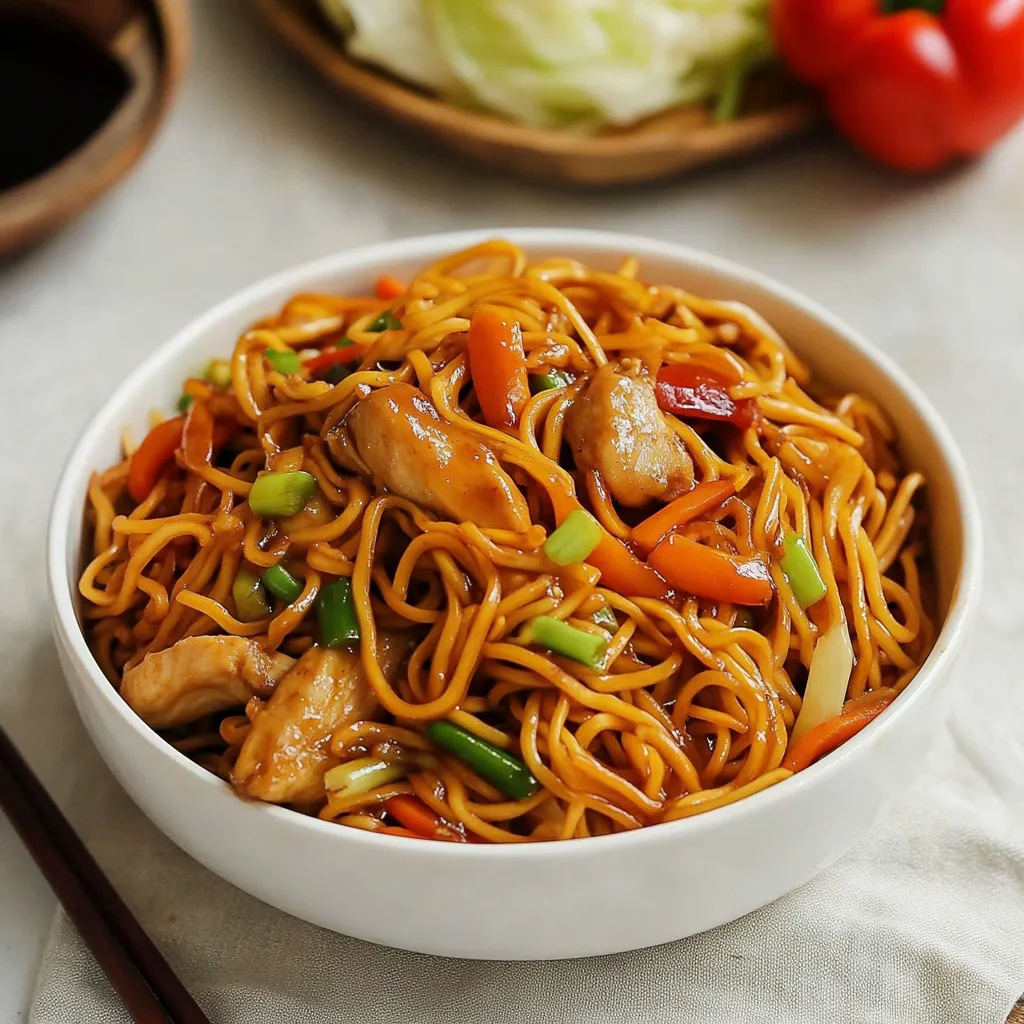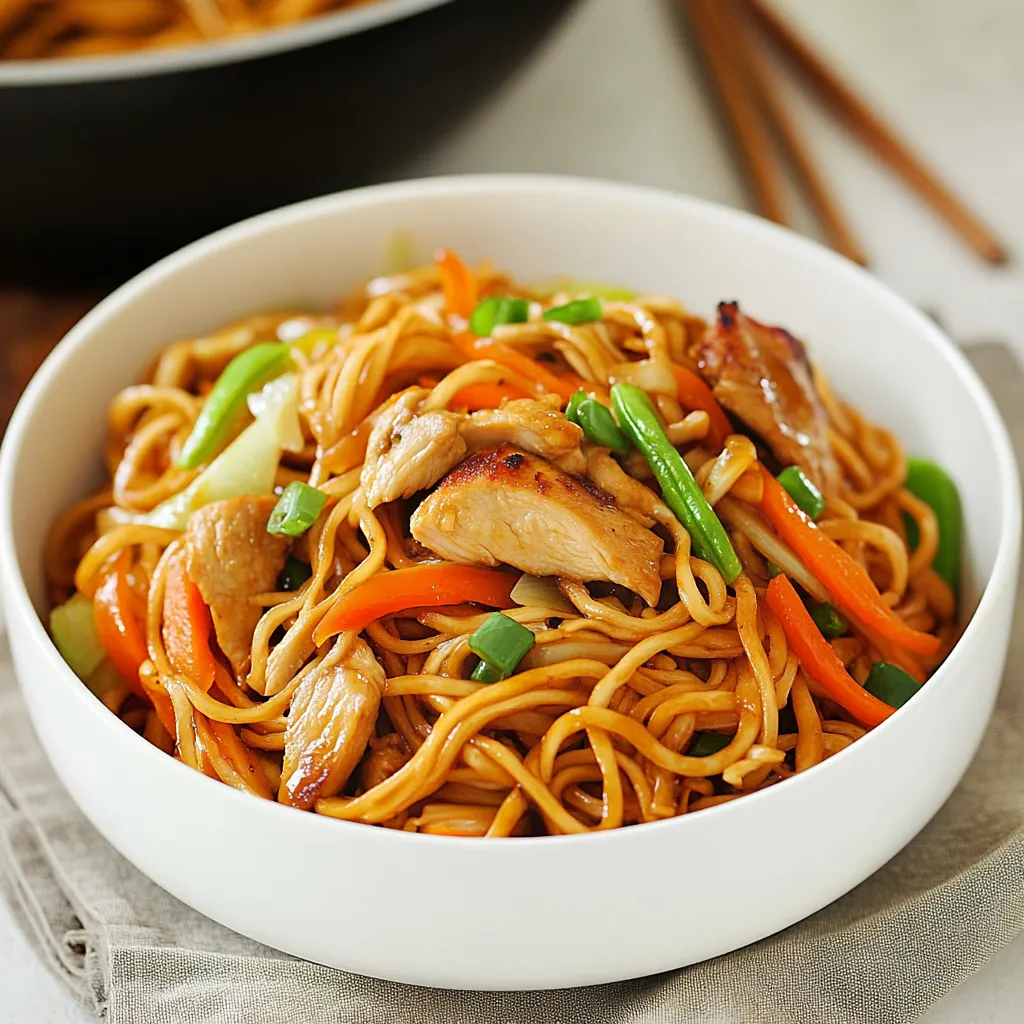 Pin it
Pin it
Steaming hot egg noodles tossed with tender chicken slices and crisp colorful vegetables create an irresistible dish that brings authentic Chinese flavors straight to your kitchen. This chicken chow mein delivers everything you love about takeout with vibrant fresh ingredients and a silky sauce that clings perfectly to each strand of noodle. After years of experimenting with different techniques and ingredients, I've perfected this recipe to capture those elusive restaurant flavors while keeping the preparation surprisingly simple.
I discovered the transformative power of proper noodle technique during a cooking class in Hong Kong's vibrant Mong Kok district. The elderly chef demonstrated how slightly undercooking the noodles before stir frying creates that perfect chewy texture restaurants achieve. My previous homemade attempts always ended with soggy noodles until implementing this crucial technique. Now my family actually prefers my version to our local takeout, especially since I can customize the vegetable mix to everyone's preferences.
Essential Components
- Egg noodles: Form the foundation of authentic chow mein with their distinctive yellow color and resilient texture that absorbs sauce beautifully while maintaining structure.
- Boneless chicken: Provides lean protein that cooks quickly and carries flavors exceptionally well when properly marinated and velveted before cooking.
- Napa cabbage: Contributes subtle sweetness and pleasant crunch while absorbing the savory sauce components without becoming waterlogged during cooking.
- Fresh carrots: Add natural sweetness and vibrant color contrast while maintaining textural integrity throughout the high heat cooking process.
- Bell peppers: Introduce slight fruitiness and appealing crisp texture that complements softer vegetables perfectly in each forkful.
- Green onions: Impart aromatic complexity with their distinctive layered flavor that brightens the entire dish when added at precisely the right moment.
- Light soy sauce: Contributes essential umami foundation without overwhelming saltiness, allowing other flavors to shine through clearly.
- Dark soy sauce: Provides rich color and subtle caramel notes that create depth and complexity in the finished sauce.
- Oyster sauce: Delivers complex briny sweetness that defines authentic Chinese cooking and cannot be replicated with substitutes.
Cooking Process
- Chicken Preparation:
- Slice one pound boneless chicken breast against grain into quarter inch thick pieces ensuring even cooking. Place chicken in bowl with one tablespoon light soy sauce, one teaspoon each cornstarch and sugar, half teaspoon each baking soda and white pepper, plus one teaspoon sesame oil. Mix thoroughly with fingers until chicken feels slightly sticky and marinade fully incorporated. Cover and refrigerate fifteen minutes while preparing other components.
- Noodle Treatment:
- Bring large pot water to rolling boil, add eight ounces dried egg noodles and cook exactly two minutes less than package directions indicate. The noodles should maintain significant chewiness as they will continue cooking during stir frying process. Drain immediately and rinse under cold running water until completely cooled, tossing frequently to prevent sticking. Drizzle with one teaspoon sesame oil and toss gently with fingers to coat each strand evenly.
- Vegetable Preparation:
- Slice two medium carrots into thin matchsticks approximately two inches long for quick cooking and attractive presentation. Cut half small cabbage into half inch wide strips discarding tough core sections. Julienne one bell pepper into thin strips similar size to carrots for consistent cooking. Slice four green onions diagonally into one inch sections separating white and green parts. Mince three garlic cloves finely to release maximum flavor during brief cooking time.
- Sauce Assembly:
- Combine three tablespoons light soy sauce, one tablespoon dark soy sauce, two tablespoons oyster sauce, one teaspoon sugar, half teaspoon white pepper, one tablespoon sesame oil, and three tablespoons water in measuring cup with pouring spout. Whisk thoroughly until sugar completely dissolves and ingredients fully incorporated. This preparation ensures sauce can be added quickly at critical moment during high heat cooking process.
 Pin it
Pin it
My grandmother always insisted that the wok must be absolutely smoking hot before adding any ingredients, a technique I initially dismissed until comparing side by side results. The properly heated wok creates that distinctive breath of the wok flavor called wok hei that distinguishes restaurant quality cooking. When I finally invested in a carbon steel wok and learned proper heating techniques, my chow mein immediately reached new heights with noticeably improved flavor complexity and texture.
Serving Suggestions
Present chicken chow mein on a large central platter allowing everyone to serve themselves directly. Accompany with small bowls of additional soy sauce, chili oil, and chopped cilantro for personalized seasoning adjustments. For an individual serving style, portion into bowls and garnish with toasted sesame seeds and extra sliced green onions.
Customization Options
For a vegetarian version, replace chicken with pressed extra firm tofu marinated using the same ingredients. Substitute seasonal vegetables such as snow peas, mushrooms, or zucchini to adapt the dish based on available ingredients. For an extra kick, stir in chili oil or thinly sliced fresh chilies during the final toss.
Storage Wisdom
Store leftover chow mein in an airtight container in the refrigerator for up to three days. Reheat in a skillet over medium-high heat with a tablespoon of oil and a splash of water, tossing frequently until heated through. Avoid microwaving, as it can make the noodles mushy.
 Pin it
Pin it
Making chicken chow mein at home connects me with centuries of cooking tradition while providing immense satisfaction through creating authentic flavors using simple techniques. The transformation that occurs during that final minute when sauce meets noodles remains magical every time. While requiring some orchestration of timing and ingredients, this recipe rewards with results surpassing restaurant versions through ingredient freshness and customization possibilities. Watching friends and family devour this humble yet impressive dish reminds me why sharing food remains one of life's most fundamental pleasures.
Frequently Asked Questions
- → What's the secret to tender chicken in chow mein?
- The key secret is marinating the thinly sliced chicken with a mixture of cornstarch, baking soda, and soy sauce. The baking soda breaks down the meat fibers, while the cornstarch creates a protective coating that keeps the chicken juicy during high-heat cooking.
- → Can I use different vegetables in this chow mein?
- Absolutely! Chow mein is very flexible - try adding bean sprouts, broccoli, snow peas, mushrooms, or baby corn. Just remember to add harder vegetables earlier in the cooking process and delicate ones toward the end.
- → What's the difference between light and dark soy sauce?
- Light soy sauce provides saltiness and flavor but is thinner and lighter in color. Dark soy sauce is thicker, less salty, slightly sweeter, and adds the beautiful brown color to dishes. Using both gives chow mein its authentic flavor and appearance.
- → Can I make this dish with other proteins?
- Yes, you can substitute the chicken with beef, pork, shrimp, or tofu. For beef or pork, use the same marinade. For shrimp, reduce marinating time to just 5 minutes. For tofu, you can skip the marinade and just toss it in cornstarch before frying.
- → Why do I need to rinse the noodles with cold water after boiling?
- Rinsing the noodles with cold water stops the cooking process immediately, preventing them from becoming mushy. It also washes away excess starch that would make the noodles stick together, giving you perfect individual strands for stir-frying.
